This week, let's focus on discussing ETH:
In the previous week's normal price correction, some people turned bearish on ETH, claiming the bull market was over, and the triple top was being discussed. Last week, ETH's price quickly surged again, and interestingly, a large group of media KOLs saw the sky again. This group of self-media was the same as those who shouted ETH would reach 800 a few months ago...
In the past two days, there has been more discussion about ETH - Ethereum will surpass Bitcoin!
A familiar feeling; the last time I heard this sentence was in 2021, when all media were promoting ETH, and few looked at BTC...
At that time, it was the second half of 2021; looking back, that was the tail end of the bull market, the highest point for ETH in years... When most media collectively FOMO and see the sky, everyone should be cautious!
The following picture is from Chinese KOLs, just flipped through it and found it has quite a few views. (The same group of people collectively FUD and bearish on ETH a few months ago)
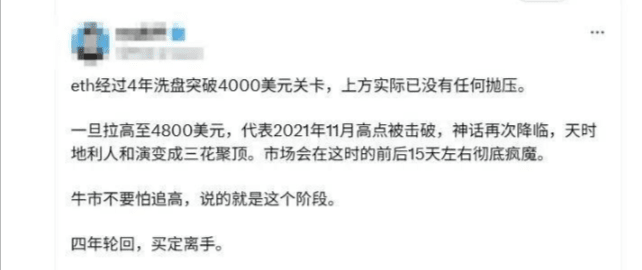
Similar to well-known KOLs in the Western world, many see around 10,000. There are also those seeing 20,000; the two images below are viewpoints from well-known KOLs in the English-speaking world, with screenshots of headlines from top global media.

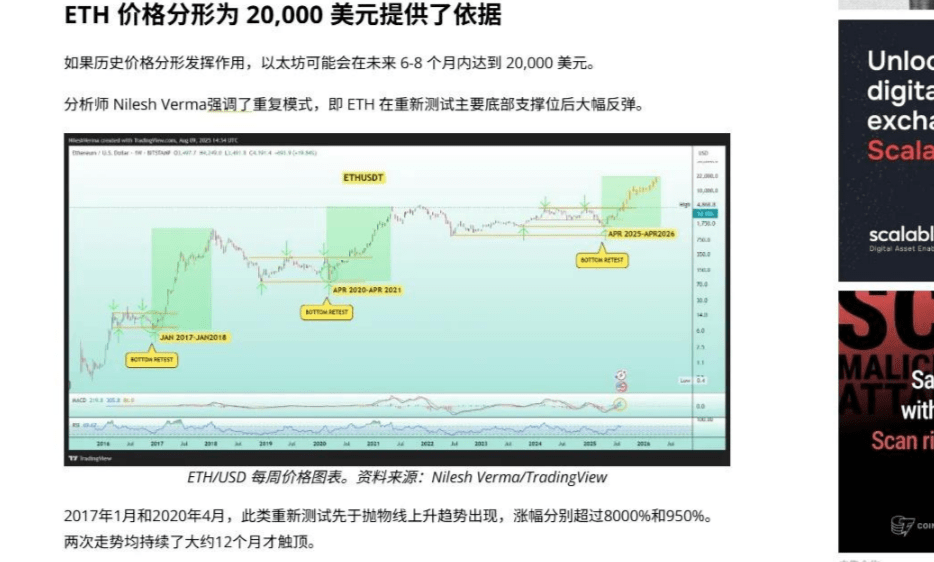
Currently, BTC ranks 6th in global asset rankings, belonging to the first tier 2 trillion club, almost on par with Google at 5th place and just a step away from Apple at 4th place. ETH is currently in the third tier of the total list, ranking 26th.
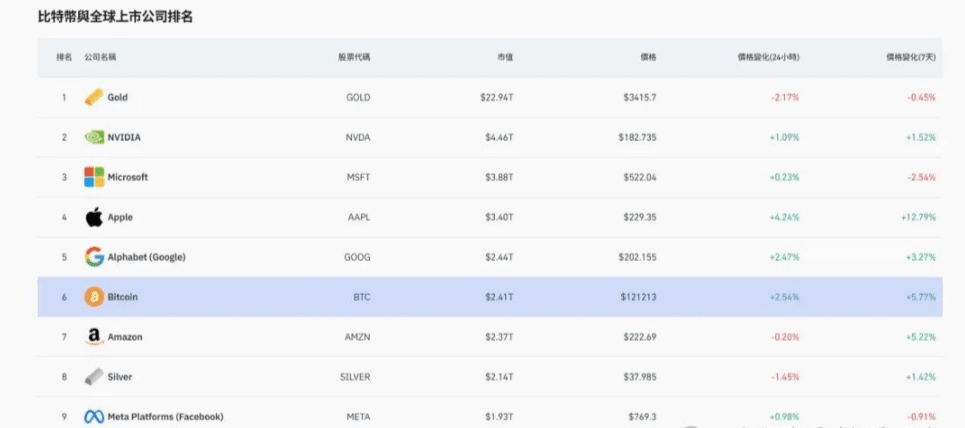
Currently, the market capitalization of Bitcoin is approximately 2.4 trillion, and the market capitalization of ETH is about 510 billion. If these KOL statements suggest ETH could reach 20,000, it would increase by about 4.6 times, indeed aligning its market cap with BTC. But can it really reach 20,000? My answer is absolutely not possible this round!!!
Most domestic KOLs serve exchanges and project parties, while foreign media analysts not only serve project parties but now also serve Wall Street, following the traditional stock market playbook, where promoting tokens is part of their job.
Long-time followers of mine know that when the price continues to drop, and the market bottom is collectively despairing, when the media collectively FUD and see the floor, I will remind everyone not to FUD and not to despair; opportunities often arise at this time. When prices continue to rise, and the media collectively FOMO, and KOLs see the sky, we remind everyone to treat it rationally and be cautious of market tops.
I deeply detest the media's little tricks and understand their operating modes so well that I can confidently state this. In the crypto market, as long as you maintain contrarian thinking, adhere to being a minority, and follow this principle, it is difficult not to make a profit, let alone lose money.
So I would like to alert those who are currently FOMOing. Today, let's talk about ETH from a broader perspective, examining the fundamental value paradox of ETH:
In terms of positioning, the two major cryptocurrencies, BTC and ETH, have the clearest positioning, and it has remained unchanged. BTC is positioned as digital gold, generally falling under the category of currency. ETH is positioned as a world computer, focusing on the blockchain application category.
Because ETH's positioning determines its high performance requirements for public chains, it needs to support large-scale commercial applications globally in the future. Therefore, it had to choose to transition from POW to POS consensus mechanism. Initially, there was the idea of sharding on the ETH main chain, but during the last WEB3 concept boom, it was overhyped. Due to insufficient performance and long waiting times for sharding, Vitalik's strategy was to fully transition to L2, building around L2 and abstracting and modularizing the ETH main chain. Later, WEB3 was gradually debunked, and the four major Layer 2 solutions became dead chains, with severe homogeneity among on-chain projects and no breakout projects. Last year, Vitalik also suggested wanting to switch back to the POW model and abandon the L2 strategy...
For ETH to break out, the price must rise to 20,000, which fundamentally relies on the underlying fundamentals. If the fundamentals cannot support it, no matter how much manipulation or hype is created in the short term, it can only be temporary.
ETH's biggest fundamental weakness currently lies in its adoption rate; the current rate of adoption is far below expectations, let alone large-scale commercial use. The gap with WEB2's leading applications is very significant. Here are some data on the disparities:
The user scale gap of the ETH chain (including Layer 2 ecosystems) reaches an order of magnitude of a hundred times: On August 5, ETH recorded 683,000 active addresses on-chain, close to the historical peak level of 2021. Layer 2 combined handles only about 13 million, while the WEB2 world has over 2 billion daily active users in leading social apps like Facebook. The mainnet gap is hundreds of times. If it were real active user numbers, the data gap would be even larger.

Let's look at the difference in trading volume; recent data shows that on August 5, Ethereum processed 1.87 million transactions - the busiest day on-chain in 19 months. Slightly below the peak record of 1.96 million transactions, Layer 2 processes less than 1 million transactions weekly. And Visa alone processed 750 million transactions daily last year. The gap is really enormous.
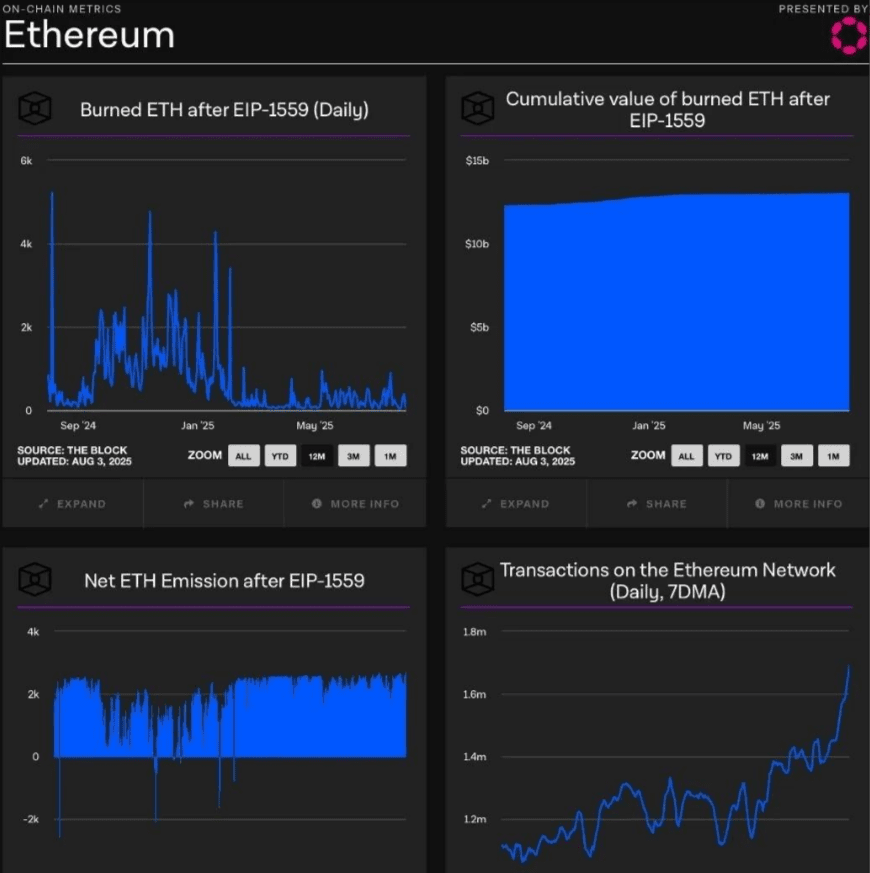
Today, ETH's TVL data also hit a new high, only at 306 billion dollars. The WEB2 world has no measure for TVL, but indirectly, looking at the basic infrastructure of different internet eras, the market value of Microsoft's foundational infrastructure in WEB2 reached 3.8 trillion, and PayPal's annual payment volume is 1.4 trillion dollars.
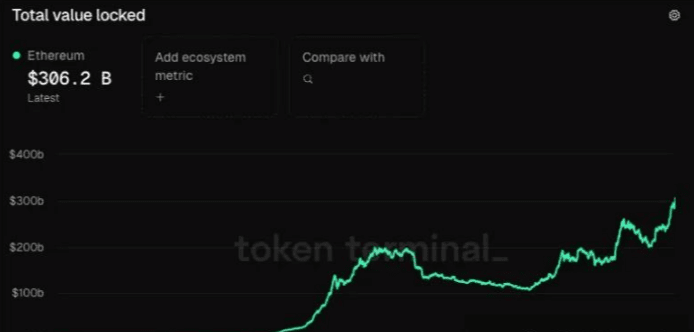
Technical bottlenecks and gaps: The ETH mainnet TPS is only about 15, while the theoretical peak after Layer 2 expansion is about 10,000 TPS, whereas Visa's actual peak can reach 65,000 TPS, which is more than a 6-fold difference. Ethereum's transaction delay (confirmation time in minutes) is far greater than the millisecond-level response of Web2 (like WeChat Pay).
At the EthCC conference in July, Drake stated that the ETH mainnet would reach 10,000 TPS using zkEVM technology. Without discussing whether this can be achieved, even a peak of 10,000 is still far from large-scale commercial use...
No need to mention the gap in user thresholds and user experience; everyone knows the disparity is huge...
The ETH mainnet has been online for exactly 10 years, and WEB2 has undergone tremendous changes. Over the years, ETH's development can only be described as disappointing and far from meeting the expectations of carrying the next generation of the internet.
Friends who worked in technology years ago told me that due to the bottlenecks of blockchain technology and the pursuit of decentralization, it is technically difficult to achieve the performance of WEB2 centralized databases. I didn't believe it at first, but over time, after interacting with more technical teams, I understood that it is indeed the case.
A few months ago, when everyone was collectively bearish on ETH, I said a sentence that still holds true today - the problem lies in blockchain technology itself, not in ETH; ETH is merely the scapegoat. It carries the future and hope of the global internet, but the greater the expectation, the greater the disappointment!
The paradox of ETH's value versus price: Due to the blockchain technology determining that ETH's performance is difficult to improve significantly, and ETH's positioning as a world computer, as an infrastructure platform, it should not have a high price in order to carry the next generation of internet applications on a large scale. Because of the decentralized nature of blockchain and the mechanism of coexistence of public chain tokens, when the value of ETH is too high, its GAS fees also rise correspondingly, which directly limits its adoption rate, making large-scale commercial use out of the question. When it truly enters the mainstream world to support commercial use, only when the price of ETH is lower can its adoption rate possibly be higher (currently, the opposite is true because it has not truly entered the large-scale application stage and remains in a speculative expectation phase).
Imagine when the price of ETH reaches 20,000, the GAS fees will multiply, and the cost of regular on-chain operations will reach tens of dollars, and during congestion, it could reach hundreds of dollars. It will truly be an aristocratic chain, and how many people can afford it? Also, imagine if, over a decade ago, an operating system, being a basic infrastructure of the internet, was sold to you for 20,000; the glorious era of WEB2 might not have happened.
The value of ETH is directly positively correlated with its adoption rate (temporary hype cannot sustain long-term). Here lies the paradox of value versus price!
Last week's increase in ETH was directly related to multiple continuous positive factors:
Since July 10, over 1.035 million ETH (4.167 billion dollars) have been accumulated by multiple unknown whales/institutions through exchanges or institutional business platforms. Most of the ETH accumulated in these addresses should belong to institutions or companies holding ETH reserves (excluding a few major ETH reserve companies, not including ETF increments), with an average accumulation price of about 3546.
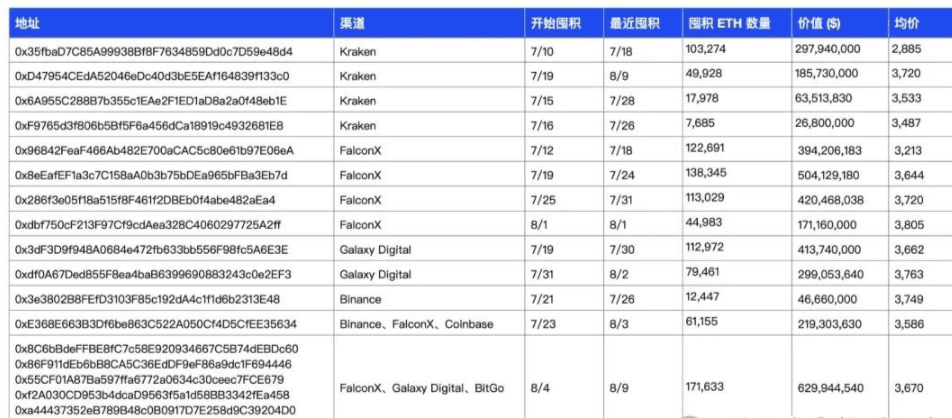
On August 5, the U.S. Commodity Futures Trading Commission launched the 'Crypto Sprint' initiative: proposing to include spot crypto assets in CFTC-registered futures exchanges (DCM) for compliant trading. This move not only breaks the long-standing regulatory gray area in the spot market, but also allows ETH's leading altcoins to benefit first.
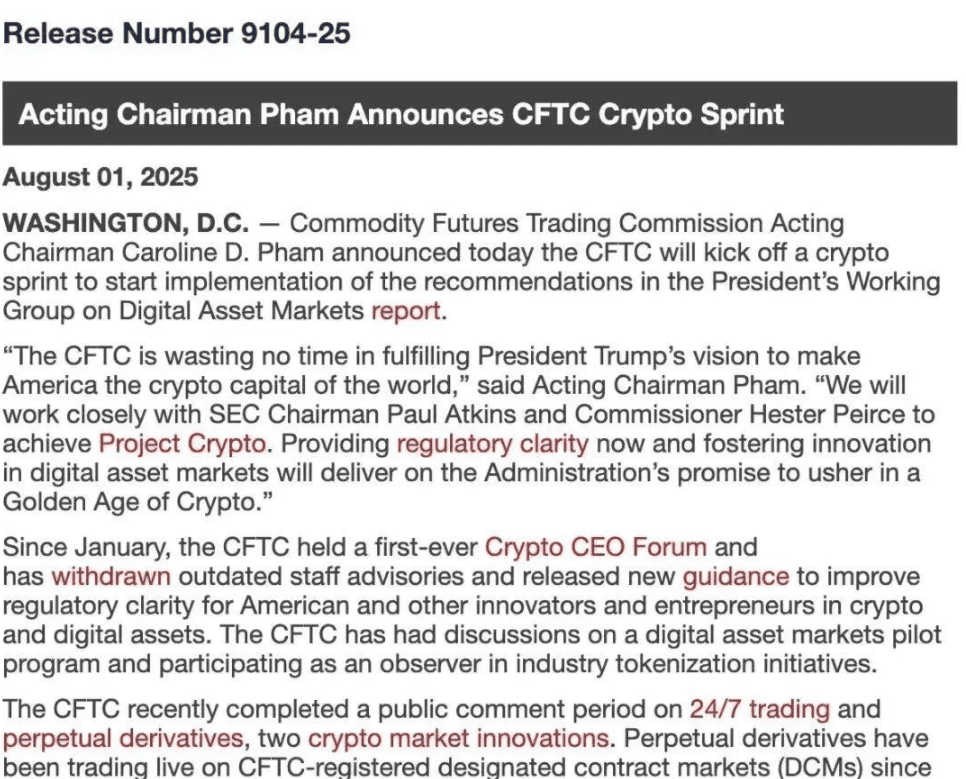
On August 5, the U.S. cracked down on 'de-banking' and relaxed custodial regulations, prohibiting banks from cutting services to crypto companies for political reasons, with violators facing penalties. In the last bear market, mainstream institutions had to give up cooperation with crypto institutions, but now it is directly relaxed.
At the end of last week, a major positive news came: Trump signed an order allowing 401(k) investments in cryptocurrency and opening the retirement market (August 7 executive order). Once the news was announced, BTC and ETH responded immediately. This is a major positive development.
Currently, the total scale of the U.S. 401(k) plan has reached 8.7 trillion dollars (accounting for 20% of the 43.4 trillion dollars of retirement assets in the U.S.). If a conservative estimate allocates 1% to cryptocurrency, it would bring about 87 billion dollars in new funds; if 5% is allocated, it could reach 435 billion dollars. BTC and ETH are the primary targets.
(However, it should be noted that executive orders need to be revised by the Department of Labor, SEC, and other departments, which are expected to take 6-12 months to complete regulatory adjustments, meaning this influx of funds will officially enter next year.)
The ETF data last week performed well, with a net inflow of 460 million dollars on the 8th.

On-chain data, TVL, and other metrics are all maintaining growth. The growth of on-chain data complements the price, often serving as a supporting force for price increases.



From a technical perspective, while last week's weekly closing was a bullish candle, the trading volume did not follow, which is not very ideal. A reliable breakout at a key position requires accompanying trading volume.
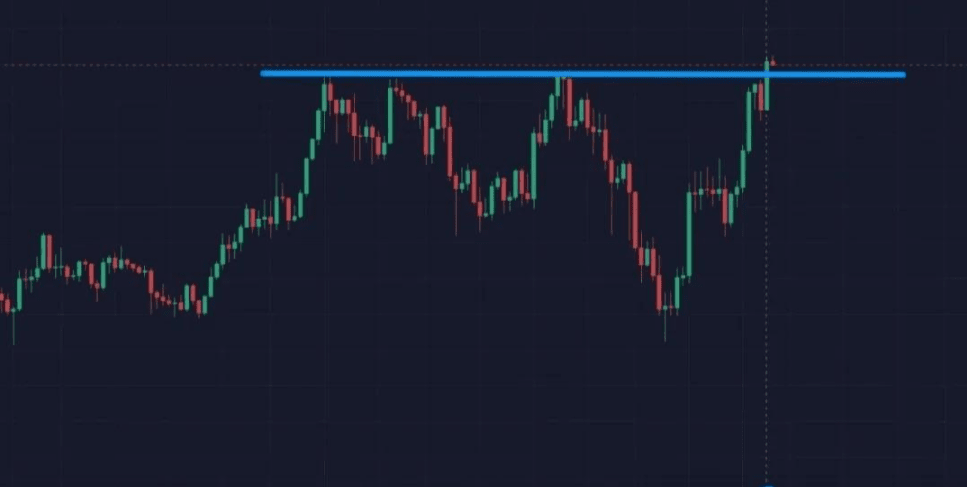
The upper pressure is at 4800, and the lower support range is at the 4000 integer level. ETH spot is suitable for large-scale pullback entry and should never chase high. The contract approach is best skewed towards right-side long positions. For months, I have repeatedly stated that even if you are not optimistic about ETH, you should not short it. I have found that there are still partners privately shorting ETH, only to come back seeking help when facing liquidation; going against the trend in contracts is one of the major taboos.
Why emphasize that one should not short ETH?
First, the large-scale structure is still in an upward trend and has not turned around;
Second, it has been performing very strongly in recent months. Shorting should be done on the weak ones; starting to short ETH was a mistake.
Third, this is indeed the reason I reminded last week; currently, any unknown positive news could stimulate a price increase at any time.
Last week's trends were mainly driven by continuous positive news, stronger than I expected. Normally, the price would consolidate in the important range around 4000 for some time. From experience, such rapid increases without sufficient consolidation are often not sturdy enough.
As for the potential endpoints of ETH in this round of market, they are still the previously measured figures: one is 6400, and the other is 9700.
Currently, the FOMO sentiment around ETH is not particularly strong. If the price continues to rise, it won't be long before these media KOLs collectively see the sky, and everyone should be cautious!
ETH




